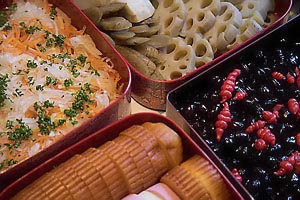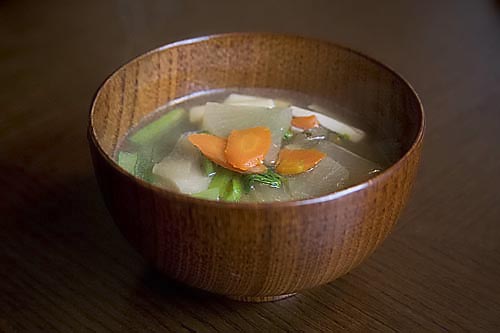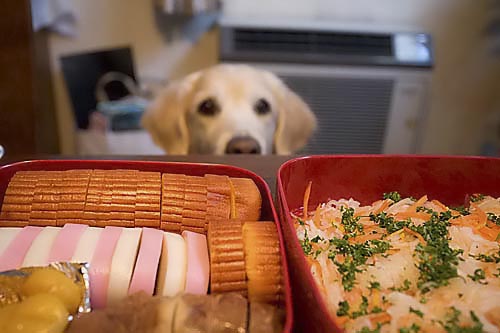Traditional fare on New Year Day in Japan is called osechi ryouri (おせち料理). Like the toshi koshi soba you're supposed to have on New Year's Eve, most of the food that makes up osechi ryouri carries a meaning.

First, the term "osechi" probably derives from the term osekku (お節句), which refers to the traditional practice of offering thanks to spirits/ gods for the harvest. This involved sharing a meal, and was practiced five times a year.
Eventually, this evolved into a once-a-year event at New Year, and in addition, took on a different signficance. Osechi ryouri is prepared in large quantities and served for the first three days of the new year. This is meant to give housewives a 3-day break at the beginning of the year from the daily chore of preparing meals.
A few decades ago, it was probably quite common for nearly every household to prepare osechi ryouri. There's a lot of work involved, and it makes sense when there's a large gathering of people, like two or three generations living together under one roof.

These days, with more single people and young people who live away from home, the number of people preparing their own osechi seems to be decreasing. Instead, you can order your osechi ryouri sets in advance from department stores and other places, and even have it delivered to your home.
I prefer mine homemade.
Some of the things that are quite common in osechi ryouri (and their symbolic meaning based on play on words) include:
- Seaweed roll (昆布巻き) — happiness
- Black soybeans (黒豆) — smooth progress in work
- Chestnut and sweet potato mix (栗きんとん) — accumulation of wealth
- Shrimp — long life
- Red and white fish cakes (かまぼこ) — red and white are traditional celebratory colours in Japan
There's more, but that gives you an idea. Basically, there's lots of good, healthy food (plenty of vegetables, not much fried food, and essentially no red meat), and you're supposed to feast on it for three days, along with healthy portions of sake.
